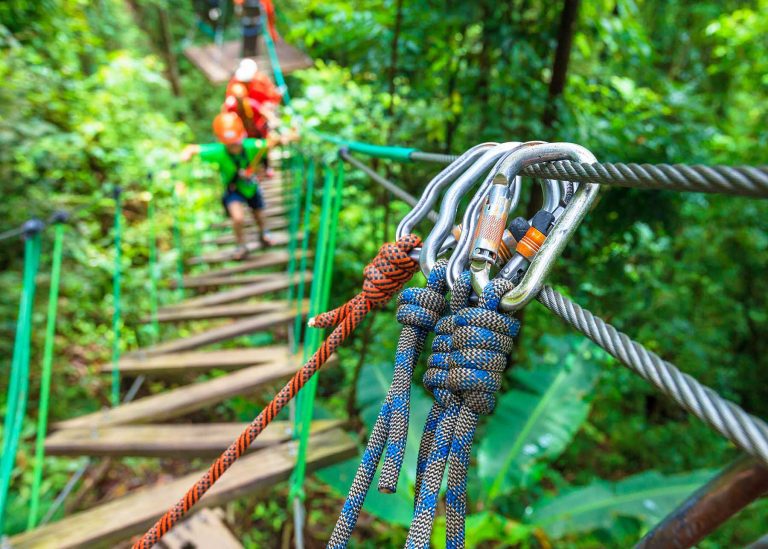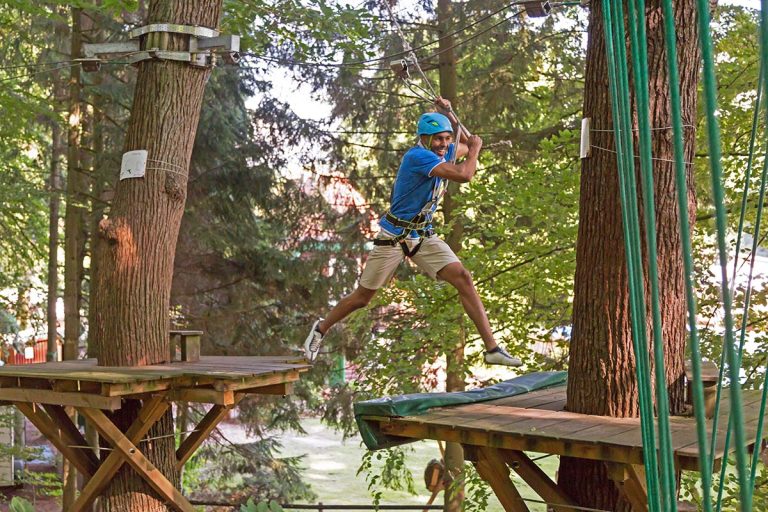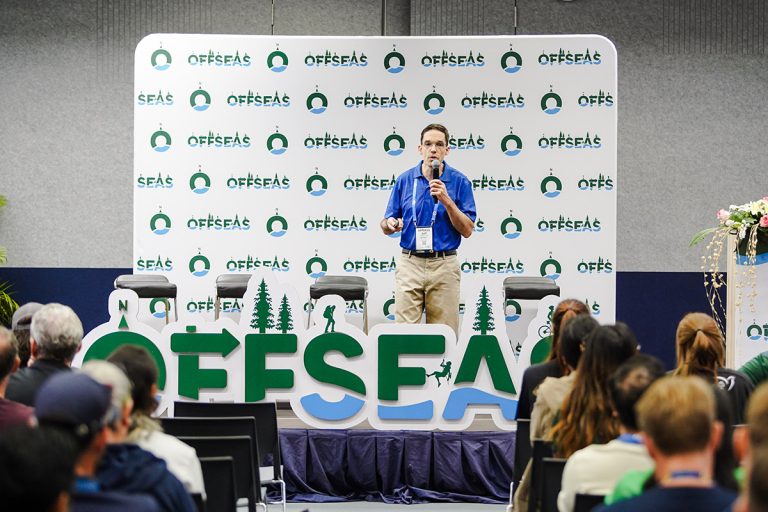
A high ropes challenge course facilitator was sentenced to six months in jail today, following the death of a challenge course participant, who died from asphyxiation after falling from a challenge course in 2021.
The 23 year old facilitator was responsible for physically checking participant harnesses to ensure that they were properly and snugly fitted to participants.
However, the facilitator only visually inspected some harnesses.
A participant, Jethro Puah Xin Yang, slipped from the “Postal Carrier’s Walk” (also called Postman Walk) on the Canopy Sky Walk at the Safra Adventure Sports Centre in Yishun, Singapore, where individuals walk along a horizontal steel cable suspended in the air, holding on to an upper rope for balance.
After slipping off the foot cable, Jethro was unable to pull himself back up. Two facilitators from nearby towers arrived at his location and attempted to hoist him back up, but were also unable to do so. They wrapped daisy chains (safety lines) under his armpits to help ensure he didn’t fall all the way out of his harness onto the ground.
The leg loops on his full-body harness were loose, and shifted from his upper legs to his waist. The leg loops became unbuckled, and 15-year-old Jethro was suspended by the shoulder straps of his harness at his armpits.
The court heard that because his leg loops were loose, he was in a lower position than someone with a properly secured harness would be if they slipped off the foot cable. As a result, it was more difficult for him to get back on the cable. As he was suspended, Jethro’s head was about at the same level as the foot cable.
He said he was “suffocating.” He was gasping for air, as his fingers turned blue and his face became pale. Eight minutes after falling from the high ropes element, Jethro became unresponsive.
The challenge course’s rescue system involved lowering a participant to the ground by their harness, but this was not immediately possible for Jethro as his harness was not securely attached to his body. A facilitator performed a pick-off maneuver, attaching Jethro to themselves, and the two were lowered to the ground.
It was now over 30 minutes since Jethro slipped off the foot cable. He had no breathing and no pulse. Facilitators began CPR.
Jethro was taken to a hospital, where he was declared dead from traumatic asphyxia and compression of the neck. He had a fractured neck bone.
In court, the facilitator’s lawyer acknowledged that the facilitator was aware that not doing a physical check could potentially endanger the participant’s life, but stated that his client was “deeply remorseful” and that the death was something the facilitator never imagined could have happened.
A forensic analysis of the harness showed it was fully functional, and would not have moved up Jethro’s suspended body if it had been properly secured.
The facilitator, who was an unpaid volunteer, pleaded guilty to causing grievous hurt by committing a rash act which endangers human life. He had been volunteering with the challenge course operator since 2017, and had completed an adventure instructor training held by the company in 2020. This was his first time in the “dispatcher” role, which checks participant harnesses and helmets before participants begin the challenge course.
Company also Criminally Charged
In addition to the facilitator, Muhammad Nurul Hakim Mohamed Din, being charged, the operator of the challenge course, Camelot, was criminally charged. The case involving Camelot, which also includes its officer Liew Foo Loong, is in process, with a hearing scheduled for February 15.
Liew is facing penalties of a fine of up to SGD 200,000 and up to two years in jail. Camelot faces a fine of up to SGD 500,000.
Camelot operated the high ropes challenge course installation at Safra Yishun, where on February 3, 2021 the victim and his classmates from Anglo-Chinese School (Independent) were participating in team-building activities organized by the school.
Camelot has been charged under Singapore’s Workplace Safety and Health Act for three workplace safety lapses:
- Failing to ensure proper training and instruction were provided to instructors on rescue operations if a rope harness becomes loose or unsecured.
- Failing to ensure adequate supervision in the donning of safety harnesses by participants
- Failing to ensure the harnesses were properly maintained
The charges allege that the failure to take these reasonably practicable measures caused the death of Jethro Puah.
Systemic Changes in Adventure Activities
Following Jethro’s tragic death in 2021, the Singapore government indefinitely halted all height-based activities (such as challenge courses, ziplines, aerial adventures and canopy tours) for all school groups across the entire country.
The suspension was lifted in February 2023, at the same time that significant requirements for height-based activities were put into force.
Challenge course operators must be accredited by the Association for Challenge Course Technology (ACCT), and facilitators must be appropriately qualified, for example by obtaining certification from ACCT or the European Ropes Course Association.
In addition, a public-private Outdoor Adventure Education Council was formed to develop safety and quality standards for adventure activities across the nation.
Analysis
Courts generally seek to assign blame and impose consequences. This is different from the role of incident investigators (such as governmental entities like the Marine Accident Investigation Branch or the National Transportation Safety Board, or private firms and consultants such as Viristar, which conducts incident investigations). Incident investigators work to identify underlying causes of incidents, and publish recommendations which can help prevent the recurrence of similar incidents. In a number of major mishaps, legal proceedings and incident investigations both proceed, separately and simultaneously.
This distinction is important, because it recognizes that criminal and civil court proceedings might not be optimally effective by themselves in improving safety practices and ensuring better safety outcomes in the future.
It may be that both structures play important roles in a society. This could be particularly the case with willful or wanton misconduct like intentionally and knowingly causing harm—which is not alleged to be the case in the Safra Yishun incident.
In the case at Safra Yishun, a young adult was volunteering to help children build character and life skills though overcoming adventurous challenges. Through his lawyer, the facilitator acknowledged exercising poor judgment—something that from time to time all of us do.
During court proceedings, the facilitator’s attorney said that the facilitator wishes to state that he “deeply regrets the passing of the deceased.” “Not a day goes by without him thinking about the incident, what he or his other instructors could have done differently,” his attorney said.
And so it can come across as sad that a person who appeared to have the best of intentions—and also made a tragic error of judgment—should spend months in jail as a result.
Yet: being well-intentioned, making an honest mistake, being youthful, engaging in socially salutary work, working without pay, and showing remorse are not excuses to cause harm.
And six months of incarceration, of course, pales in comparison to the terrible and life-long grief and emotional trauma that may be suffered by Jethro’s family members, loved ones, close friends, and even those at his school and who were at the challenge course operation. The loss of one’s child is without a doubt a tragedy of the highest order.
Nothing can bring back the life of a promising 15 year old child, known as a loving son, outstanding student, musical talent, and caring friend.
And it’s critical that every reasonably practicable measure be taken to prevent such a terrible loss.
Alongside that, the tragedy at Safra Yishun brings to mind another high ropes challenge course incident—one where a young girl was injured on a zipline, and rushed to the hospital via ambulance—and yet no civil or criminal charges were laid. No employee faced punishment, but following an internal incident review, significant operational changes were made at the adventure organization.
This illustrates the idea of Just Culture in systems-based safety theory, which sees incidents as generally a product of poor organizational safety culture, rather than being caused solely by the individuals most directly connected (in time or space) to the mishap. Just Culture, which has some linkage with the idea of restorative justice, can help prevent future incidents by helping to uncover and address the underlying causes of an incident.
In risk management processes informed by complex socio-technical systems theory, errors—such as making a poor judgment call—are seen as consequences, not causes.
An error can be understood to often be a consequence of underdeveloped organizational safety systems—a symptom of organizational shortcomings—and not the core reason an incident occurred.
Why did the Camelot facilitator fail to check the harnesses of four challenge participants (the last of whom fell and was asphyxiated)? Could contributing factors be a deficit in their training? A corporate culture that prioritized pushing a high number of participants through the course in a short time?
And could other measures—such as quicker access to and application of a rescue kit, or more effective procedures for the other facilitators involved in rescue attempts—have prevented the tragedy? Were insufficient or absent voluntary or compulsory safety standards from industry bodies or the government a potential contributing factor?
The court case did not answer these questions. But systems-informed incident causation theory tells us that to prevent similar tragedies, these types of questions should be addressed.
It’s heartening, therefore, to know that the Singaporean government instituted the high elements safety requirements that it has, and that government bodies and the private sector are joining to establish safety standards for all adventure activities in the country.
These important steps can help prevent future incidents, and bring the benefits of outdoor adventure activities to more people in Singapore and beyond.




